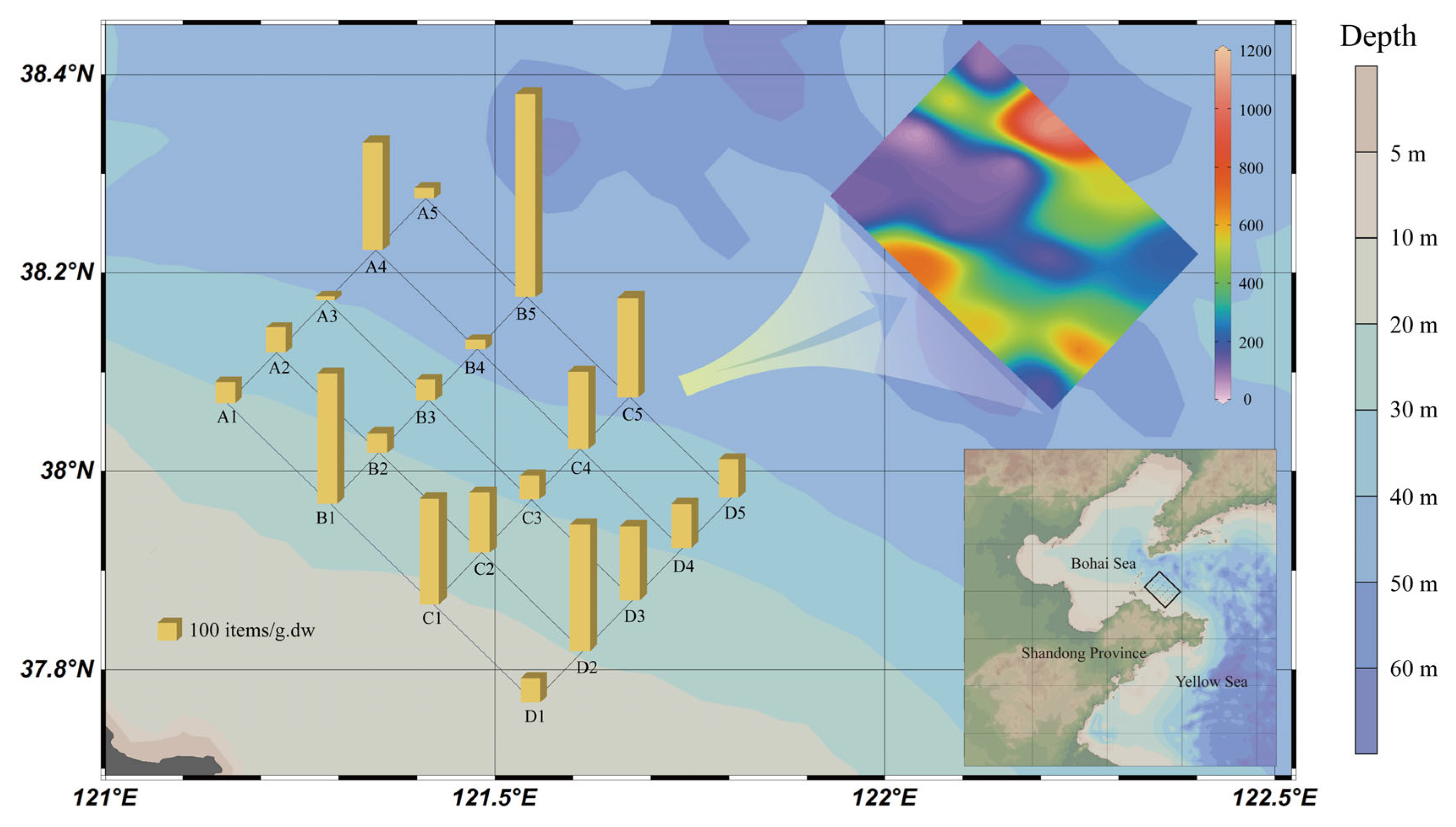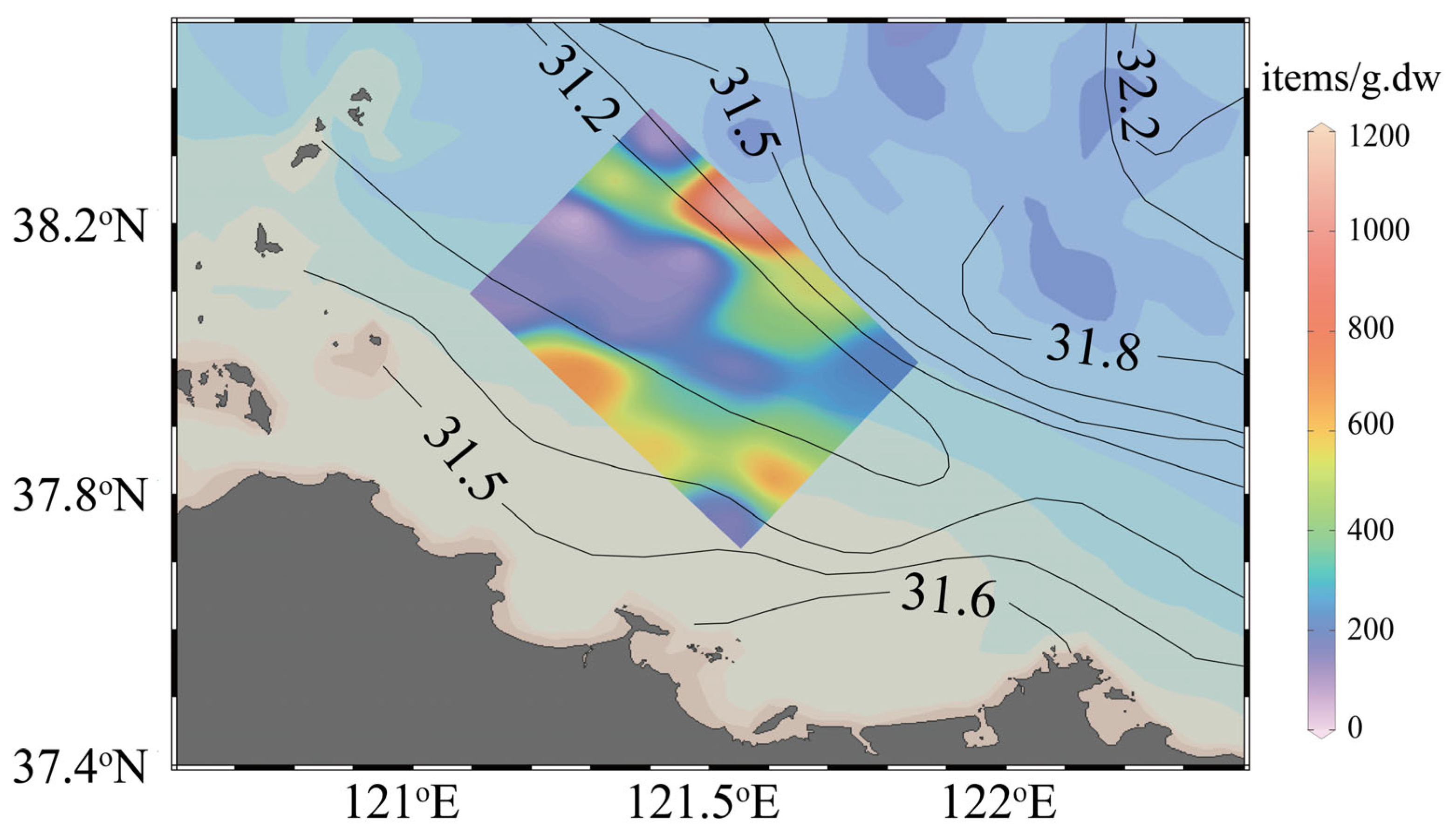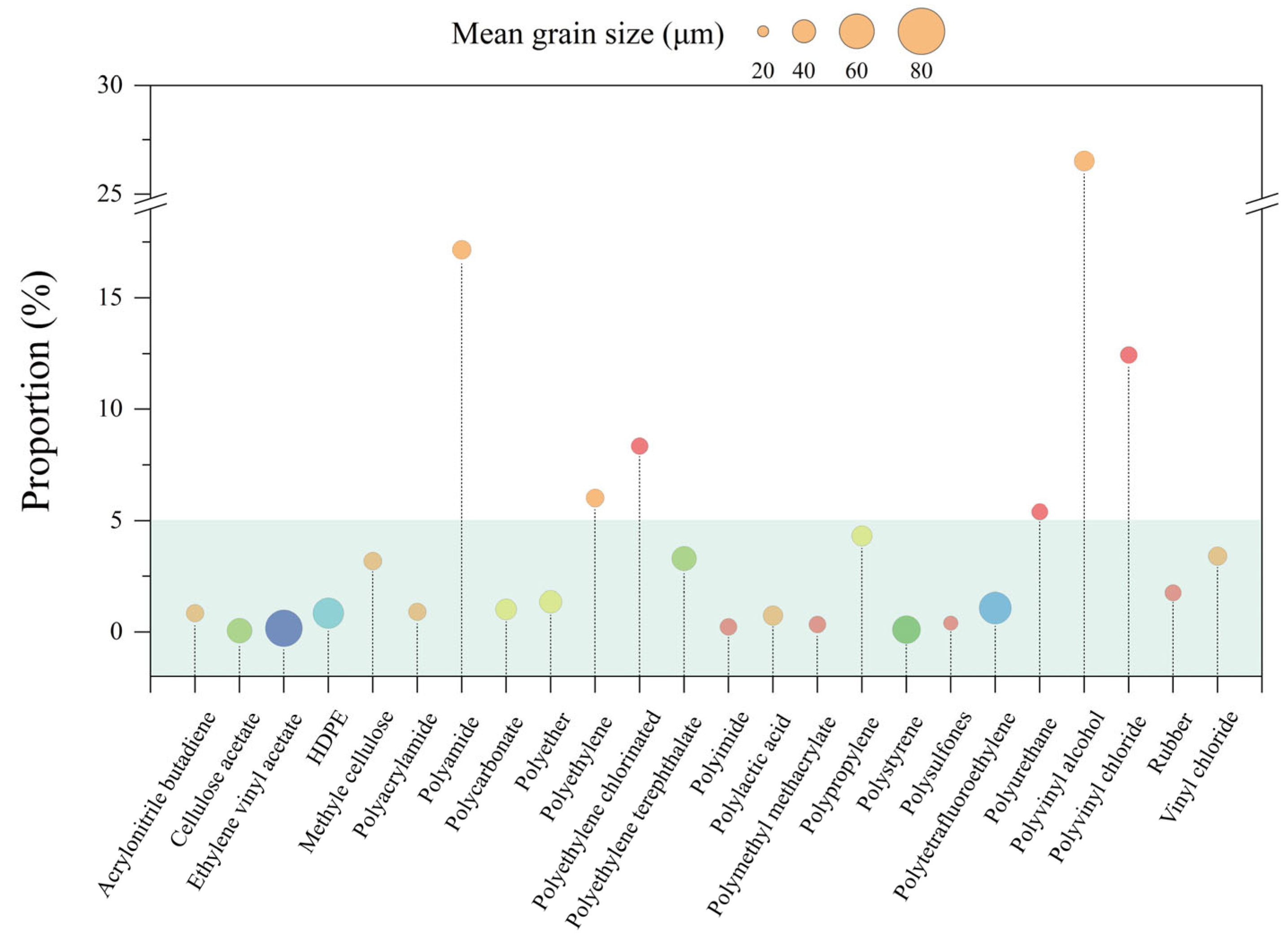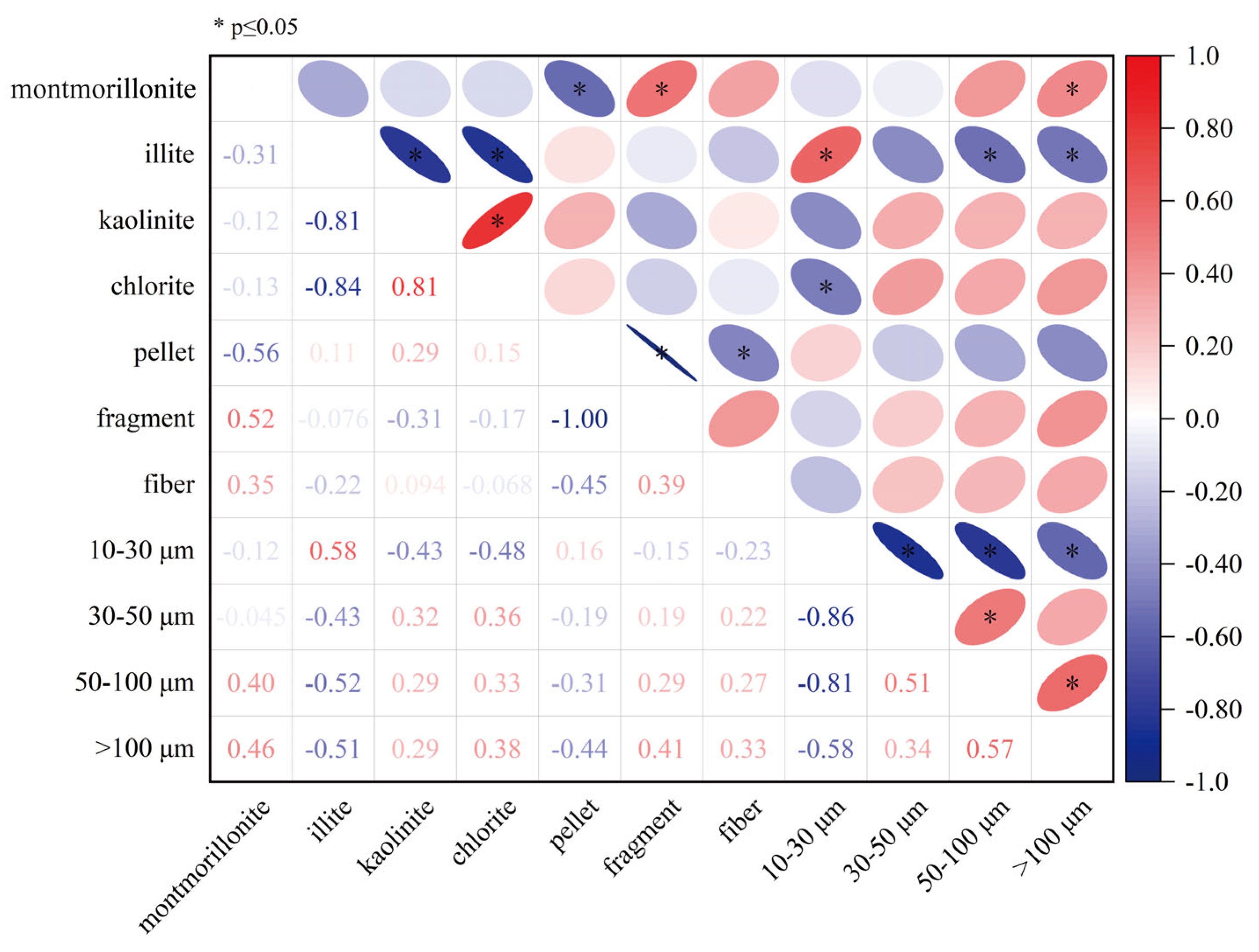The Salinity Difference and Clay Mineral Types Affect the Distribution of Microplastics in the Seabed: New Evidence from the Western North Yellow Sea
Abstract
1. Introduction
2. Materials and Methods
2.1. Sampling Site and Sample Collection
2.2. Analysis of Microplastics
2.2.1. Sample Pretreatment
2.2.2. Density Flotation
2.2.3. Organic Digestion and Detection
2.3. Analysis of Clay Mineral
2.4. Statistical Analysis
3. Results and Discussion
3.1. Abundance Distribution of Microplastics
3.2. Effect of Salinity in Bottom Seawater on the Distribution of Microplastics
3.3. Effect of Clay Minerals on the Distribution of Microplastics
4. Conclusions and Prospection
Supplementary Materials
Author Contributions
Funding
Data Availability Statement
Conflicts of Interest
References
- Strokal, M.; Vriend, P.; Bak, M.P.P.; Kroeze, C.; van Wijnen, J.; van Emmerik, T. River export of macro- and microplastics to seas by sources worldwide. Nat. Commun. 2023, 14, 4842. [Google Scholar] [CrossRef] [PubMed]
- Chen, Q.; Wang, Q.; Zhang, C.; Zhang, J.; Dong, Z.; Xu, Q. Aging simulation of thin-film plastics in different environments to examine the formation of microplastic. Water Res. 2021, 202, 117462. [Google Scholar] [CrossRef] [PubMed]
- Ramasamy, E.V.; Sruthy, S.; Harit, A.K.; Mohan, M.; Binish, M.B. Microplastic pollution in the surface sediment of Kongsfjorden, Svalbard, Arctic. Mar. Pollut. Bull. 2021, 173, 112986. [Google Scholar] [CrossRef] [PubMed]
- Erni-Cassola, G.; Gibson, M.I.; Thompson, R.C.; Christie-Oleza, J.A. Lost, but Found with Nile Red: A Novel Method for Detecting and Quantifying Small Microplastics (1 mm to 20 μm) in Environmental Samples. Environ. Sci. Technol. 2017, 51, 13641–13648. [Google Scholar] [CrossRef]
- Nihei, Y.; Ota, H.; Tanaka, M.; Kataoka, T.; Kashiwada, J. Comparison of concentration, shape, and polymer composition between microplastics and mesoplastics in Japanese river waters. Water Res. 2024, 249, 120979. [Google Scholar] [CrossRef]
- Allen, D.; Allen, S.; Abbasi, S.; Baker, A.; Bergmann, M.; Brahney, J.; Butler, T.; Duce, R.A.; Eckhardt, S.; Evangeliou, N.; et al. Microplastics and nanoplastics in the marine-atmosphere environment. Nat. Rev. Earth Environ. 2022, 3, 393–405. [Google Scholar] [CrossRef]
- Bai, M.; Lin, Y.; Hurley, R.R.; Zhu, L.; Li, D. Controlling Factors of Microplastic Riverine Flux and Implications for Reliable Monitoring Strategy. Environ. Sci. Technol. 2022, 56, 48–61. [Google Scholar] [CrossRef]
- Cunningham, E.M.; Ehlers, S.M.; Kiriakoulakis, K.; Schuchert, P.; Jones, N.H.; Kregting, L.; Woodall, L.C.; Dick, J.T.A. The accumulation of microplastic pollution in a commercially important fishing ground. Sci. Rep. 2022, 12, 4217. [Google Scholar] [CrossRef]
- Higgins, C.; Turner, A. Microplastics in surface coastal waters around Plymouth, UK, and the contribution of boating and shipping activities. Sci. Total Environ. 2023, 893, 164695. [Google Scholar] [CrossRef]
- Seo, J.H.; Shin, Y.; Song, I.G.; Lim, J.; Ok, Y.S.; Weon, S. Atmospheric microplastics: Challenges in site- and target-specific measurements. Trac-Trends Anal. Chem. 2024, 178, 117859. [Google Scholar] [CrossRef]
- Seeley, M.E.; Song, B.; Passie, R.; Hale, R.C. Microplastics affect sedimentary microbial communities and nitrogen cycling. Nat. Commun. 2020, 11, 2372. [Google Scholar] [CrossRef] [PubMed]
- Amelia, T.S.M.; Khalik, W.M.A.W.M.; Ong, M.C.; Shao, Y.T.; Pan, H.-J.; Bhubalan, K. Marine microplastics as vectors of major ocean pollutants and its hazards to the marine ecosystem and humans. Prog. Earth Planet. Sci. 2021, 8, 12. [Google Scholar] [CrossRef]
- Gandara e Silva, P.P.; Nobre, C.R.; Resaffe, P.; Seabra Pereira, C.D.; Gusmao, F. Leachate from microplastics impairs larval development in brown mussels. Water Res. 2016, 106, 364–370. [Google Scholar] [CrossRef] [PubMed]
- Pandey, D.; Singh, A.; Ramanathan, A.; Kumar, M. The combined exposure of microplastics and toxic contaminants in the floodplains of north India: A review. J. Environ. Manag. 2021, 279, 111557. [Google Scholar] [CrossRef]
- Chen, M.; Du, M.; Jin, A.; Chen, S.; Dasgupta, S.; Li, J.; Xu, H.; Ta, K.; Peng, X. Forty-year pollution history of microplastics in the largest marginal sea of the western Pacific. Geochem. Perspect. Lett. 2020, 13, 42–47. [Google Scholar] [CrossRef]
- Mu, J.; Qu, L.; Jin, F.; Zhang, S.; Fang, C.; Ma, X.; Zhang, W.; Huo, C.; Cong, Y.; Wang, J. Abundance and distribution of microplastics in the surface sediments from the northern Bering and Chukchi Seas. Environ. Pollut. 2019, 245, 122–130. [Google Scholar] [CrossRef]
- Kane, I.A.; Clare, M.A.; Miramontes, E.; Wogelius, R.; Rothwell, J.J.; Garreau, P.; Pohl, F. Seafloor microplastic hotspots controlled by deep-sea circulation. Science 2020, 368, 1140. [Google Scholar] [CrossRef]
- Bergmann, M.; Wirzberger, V.; Krumpen, T.; Lorenz, C.; Primpke, S.; Tekman, M.B.; Gerdts, G. High Quantities of Microplastic in Arctic Deep-Sea Sediments from the HAUSGARTEN Observatory. Environ. Sci. Technol. 2017, 51, 11000–11010. [Google Scholar] [CrossRef]
- Vu, T.T.T.; Nguyen, D.T.; Nguyen, N.T.M.; Nguyen, M.N. Coaggregation of micro polystyrene particles and suspended minerals under concentrated salt solution: A perspective of terrestrial-to-ocean transfer of microplastics. Mar. Pollut. Bull. 2022, 185, 114317. [Google Scholar] [CrossRef]
- Ye, X.; Cheng, Z.; Wu, M.; Hao, Y.; Lu, G.; Hu, B.X.; Mo, C.; Li, Q.; Wu, J.; Wu, J. Effects of clay minerals on the transport of polystyrene nanoplastic in groundwater. Water Res. 2022, 223, 118978. [Google Scholar] [CrossRef]
- Biscaye, P.E.Z. Mineralogy and sedimentation of the deep-sea sediment fine fraction in the atlantic ocean and adjacent seas and oceans. Geol. Soc. Am. Bull. 1965, 76, 803–832. [Google Scholar] [CrossRef]
- Ding, Y.; Zou, X.; Chen, H.; Yuan, F.; Liao, Q.; Feng, Z.; Fan, Q.; Wang, Y.; Fu, G.; Yu, W. Distribution pattern and influencing factors for the microplastics in continental shelf, slope, and deep-sea surface sediments from the South China Sea. Environ. Pollut. 2022, 309, 119824. [Google Scholar] [CrossRef] [PubMed]
- Yao, Z.; Bao, X.; Li, N.; Li, X.; Wan, K.; Song, J. Seasonal Evolution of the Northern Yellow Sea Cold Water Mass. J. Ocean Univ. China 2012, 42, 9–15. [Google Scholar]
- Yang, X.; Li, G.; Ding, D.; Wang, X.; Liu, X.; Liu, S. Spatio-temporal change of coastal current around Shandong Peninsula and transport characteristics of suspended matter. Mar. Geol. Lett. 2023, 39, 49–58. [Google Scholar]
- Xuan, J.; He, Y.; Zhou, F.; Tang, C.; Zheng, X.; Liu, H.; Yu, L.; Chen, J. Aquaculture-induced boundary circulation and its impact on coastal frontal circulation. Environ. Res. Commun. 2019, 1, 051001. [Google Scholar] [CrossRef]
- Wang, Z.; Li, W.; Zhang, K.; Agrawal, Y.C.; Huang, H. Observations of the distribution and flocculation of suspended particulate matter in the North Yellow Sea cold water mass. Cont. Shelf Res. 2020, 204, 104187. [Google Scholar] [CrossRef]
- Yu, X.; Guo, X. Intensification of water temperature increase inside the bottom cold water by horizontal heat transport. Cont. Shelf Res. 2018, 165, 26–36. [Google Scholar] [CrossRef]
- Zhang, K.; Wang, Z.; Li, W.; Yan, J. Properties of coarse particles in suspended particulate matter of the North Yellow Sea during summer. J. Oceanol. Limnol. 2019, 37, 79–92. [Google Scholar] [CrossRef]
- Liu, D.; Zheng, Y.; Chen, L.; Wen, D. Prevalence of small-sized microplastics in coastal sediments detected by multipoint confocal micro-Raman spectrum scanning. Sci. Total Environ. 2022, 831, 154741. [Google Scholar] [CrossRef]
- Liu, S.; You, H.; Mu, H.; Cheng, J.; Kuang, S.; Wang, F.; Chen, H.; Zheng, M.; Xu, Y.; Liu, T. Abundance, characteristics and risk assessment of microplastics in aquatic sediments: A comparative study in the Yellow River and Yellow Sea. Waste Manag. 2023, 172, 326–334. [Google Scholar] [CrossRef]
- Nour, H.E.; Helal, S.A.; Wahab, M.A. Contamination and health risk assessment of heavy metals in beach sediments of Red Sea and Gulf of Aqaba, Egypt. Mar. Pollut. Bull. 2022, 177, 113517. [Google Scholar] [CrossRef] [PubMed]
- Cooke, T.F. Biodegradability of polymers and fibers—A review of the literature. J. Polym. Eng. 1990, 9, 171–211. [Google Scholar] [CrossRef]
- Chen, Q.; Li, Y.; Wang, C.; Feng, L.; Zhang, Z. Degradation of mechanical properties of polyurethane elastomer coatings under different pavement pollution conditions. Constr. Build. Mater. 2023, 409, 134181. [Google Scholar] [CrossRef]
- Highland, H.A.; Wilson, R. Resistance of polymer-films to penetration by leser grain borer coleoptera, bostrichidae and description of a device for measuring resistance. J. Econ. Entomol. 1981, 74, 67–70. [Google Scholar] [CrossRef]
- Tschech, A.; Zeyer, J.; Kastien, H.; Sutter, H.P. Microbial degradation of synthetic polymers-A literature review. Mater. Und Org. 1992, 27, 203–233. [Google Scholar]
- Chamas, A.; Moon, H.; Zheng, J.; Qiu, Y.; Tabassum, T.; Jang, J.H.; Abu-Omar, M.; Scott, S.L.; Suh, S. Degradation Rates of Plastics in the Environment. Acs Sustain. Chem. Eng. 2020, 8, 3494–3511. [Google Scholar] [CrossRef]
- Xian, Y.; Zhang, Y.; Chen, L.; Wu, Y.; Zhou, H.; Chen, J. Improvement on toughness and tribological properties for phosphate bonded MoS2 coatings by introduction of polytetrafluoroethylene. J. Mater. Res. 2022, 37, 2446–2457. [Google Scholar] [CrossRef]
- Zhou, S.; Li, Y.-B.; Morsi, Y.S.; Wang, Y.-Y.; Chen, C.; Zhang, L. Effects of Ethylene-Vinyl Acetate Copolymer on the Morphology and Mechanical Properties of Hydroxyapatite/Polyamide 66 Composites for Bone Tissue Engineering. Polym.-Plast. Technol. Eng. 2014, 53, 290–297. [Google Scholar] [CrossRef]
- Vu, T.T.T.; Nguyen, N.T.T.; Duong, L.H.; Nguyen, A.D.; Nguyen-Thanh, L.; Dultz, S.; Nguyen, M.N. Coaggregation assisted by cationic polyelectrolyte and clay minerals as a strategy for the removal of polystyrene microplastic particles from aqueous solutions. Appl. Clay Sci. 2023, 233, 106820. [Google Scholar] [CrossRef]
- Wang, Y.; Chen, X.; Wang, F.; Cheng, N. Influence of typical clay minerals on aggregation and settling of pristine and aged polyethylene microplastics. Environ. Pollut. 2023, 316, 120649. [Google Scholar] [CrossRef]
- Li, M.; Zhang, X.; Yi, K.; He, L.; Han, P.; Tong, M. Transport and deposition of microplastic particles in saturated porous media: Co-effects of clay particles and natural organic matter. Environ. Pollut. 2021, 287, 117585. [Google Scholar] [CrossRef] [PubMed]
- Young, D.A.; Smith, D.E. Simulations of clay mineral swelling and hydration: Dependence upon interlayer ion size and charge. J. Phys. Chem. B 2000, 104, 9163–9170. [Google Scholar] [CrossRef]
- Farrokhpay, S.; Ndlovu, B.; Bradshaw, D. Behaviour of swelling clays versus non-swelling clays in flotation. Miner. Eng. 2016, 96–97, 59–66. [Google Scholar] [CrossRef]
- Jeong, S.W.; Locat, J.; Leroueil, S. The effects of salinity and shear history on the rheological characteristics of illite-rich and Na-montmorillonite-rich clays. Clays Clay Miner. 2012, 60, 108–120. [Google Scholar] [CrossRef]






Disclaimer/Publisher’s Note: The statements, opinions and data contained in all publications are solely those of the individual author(s) and contributor(s) and not of MDPI and/or the editor(s). MDPI and/or the editor(s) disclaim responsibility for any injury to people or property resulting from any ideas, methods, instructions or products referred to in the content. |
© 2025 by the authors. Licensee MDPI, Basel, Switzerland. This article is an open access article distributed under the terms and conditions of the Creative Commons Attribution (CC BY) license (https://creativecommons.org/licenses/by/4.0/).
Share and Cite
Li, M.; Yan, K.; Liu, J.; Yuan, Q.; Wu, S.; Bao, K.; Wang, H. The Salinity Difference and Clay Mineral Types Affect the Distribution of Microplastics in the Seabed: New Evidence from the Western North Yellow Sea. Water 2025, 17, 1492. https://doi.org/10.3390/w17101492
Li M, Yan K, Liu J, Yuan Q, Wu S, Bao K, Wang H. The Salinity Difference and Clay Mineral Types Affect the Distribution of Microplastics in the Seabed: New Evidence from the Western North Yellow Sea. Water. 2025; 17(10):1492. https://doi.org/10.3390/w17101492
Chicago/Turabian StyleLi, Mengting, Kun Yan, Jiufen Liu, Qingzheng Yuan, Shuyu Wu, Kuanle Bao, and Hongsong Wang. 2025. "The Salinity Difference and Clay Mineral Types Affect the Distribution of Microplastics in the Seabed: New Evidence from the Western North Yellow Sea" Water 17, no. 10: 1492. https://doi.org/10.3390/w17101492
APA StyleLi, M., Yan, K., Liu, J., Yuan, Q., Wu, S., Bao, K., & Wang, H. (2025). The Salinity Difference and Clay Mineral Types Affect the Distribution of Microplastics in the Seabed: New Evidence from the Western North Yellow Sea. Water, 17(10), 1492. https://doi.org/10.3390/w17101492



